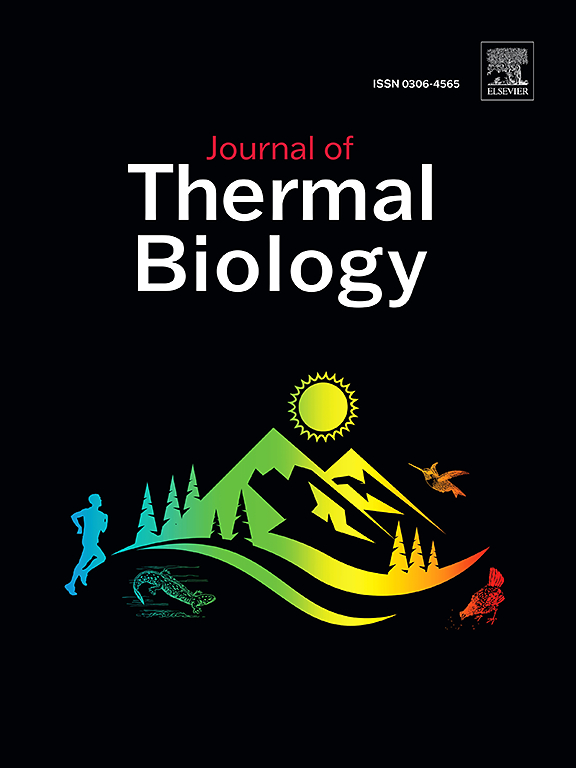Is skin temperature associated with training load during preparatory period of a professional volleyball team?
IF 2.9
2区 生物学
Q2 BIOLOGY
引用次数: 0
Abstract
The current study investigated if skin temperature (Tsk) measurement through infrared thermography could reflect the accumulation of training load during the preparatory period of a professional volleyball team. Sixteen athletes (20.1 ± 3.1 years, 88.1 ± 6.1 kg, 193 ± 0.1 cm e 13.3 ± 2.3 % body fat) were assessed over two weeks of the preparatory period (5 training days in each week) for the second division of the Brazilian Men's Volleyball Super League. After one week of familiarization with the study procedures, Tsk was measured in eight regions (anterior and posterior areas of arm, shoulder, thigh, and leg) on the first and last training days of each week, along with perceived recovery status (PRS) were measured on the first and last training days of each week. Training load for each session and total weekly training load (TWTL) were calculated using the session rating of perceived exertion (SRPE) method. Three days in the first week and four days in the second week had higher training loads (χ2 = 89.1, p < 0.001), as indicated by a significant reduction in recovery perception at the end of each week (F = 52.3, p < 0.001). Among the eight regions examined, five showed a decrease in Tsk after two rest days (weekend), while two regions exhibited an increase in Tsk at the end of the following training week (p < 0.05). Out of 44 associations examined between Tsk, PRS, and TWTL, only the associations between delta PRS and delta mean Tsk of the anterior and posterior leg were significant (β = −0.20, p < 0.045 for both). In conclusion, the data suggest that Tsk may be altered during the pre-competitive period of professional volleyball players; however, it does not appear to be associated with PRS and training load as assessed by the SRPE method.
职业排球队备战期间,皮肤温度与训练负荷是否相关?
本研究通过红外热像仪测量皮肤温度(Tsk)是否能反映职业排球队在训练准备阶段的训练负荷积累情况。对16名巴西男排超级联赛乙级赛区运动员(20.1±3.1岁,88.1±6.1 kg, 193±0.1 cm, 13.3±2.3%体脂)进行为期2周(每周5天训练)的评估。在熟悉研究程序一周后,在每周训练的第一天和最后一天测量8个区域(手臂前部和后部区域,肩部,大腿和腿部)的Tsk,并在每周训练的第一天和最后一天测量感知恢复状态(PRS)。采用感知负荷评分法(SRPE)计算每次训练负荷和每周总训练负荷(TWTL)。第1周第3天和第2周第4天的训练负荷较高(χ2 = 89.1, p <;0.001),每周结束时恢复知觉显著降低(F = 52.3, p <;0.001)。在被检查的8个区域中,5个区域在两个休息日(周末)后显示Tsk减少,而两个区域在接下来的训练周结束时显示Tsk增加(p <;0.05)。在Tsk、PRS和TWTL之间的44个关联中,只有delta PRS和前后腿的delta mean Tsk之间的关联是显著的(β = - 0.20, p <;两者都是0.045)。综上所述,这些数据表明职业排球运动员的Tsk可能在赛前阶段发生改变;然而,根据SRPE方法评估,它似乎与PRS和训练负荷无关。
本文章由计算机程序翻译,如有差异,请以英文原文为准。
求助全文
约1分钟内获得全文
求助全文
来源期刊

Journal of thermal biology
生物-动物学
CiteScore
5.30
自引率
7.40%
发文量
196
审稿时长
14.5 weeks
期刊介绍:
The Journal of Thermal Biology publishes articles that advance our knowledge on the ways and mechanisms through which temperature affects man and animals. This includes studies of their responses to these effects and on the ecological consequences. Directly relevant to this theme are:
• The mechanisms of thermal limitation, heat and cold injury, and the resistance of organisms to extremes of temperature
• The mechanisms involved in acclimation, acclimatization and evolutionary adaptation to temperature
• Mechanisms underlying the patterns of hibernation, torpor, dormancy, aestivation and diapause
• Effects of temperature on reproduction and development, growth, ageing and life-span
• Studies on modelling heat transfer between organisms and their environment
• The contributions of temperature to effects of climate change on animal species and man
• Studies of conservation biology and physiology related to temperature
• Behavioural and physiological regulation of body temperature including its pathophysiology and fever
• Medical applications of hypo- and hyperthermia
Article types:
• Original articles
• Review articles
 求助内容:
求助内容: 应助结果提醒方式:
应助结果提醒方式:


